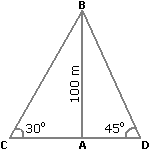Let AB be the lighthouse and C and D be the positions of the ships.

Then, AB = 100 m,  ACB = 30° and
ACB = 30° and  ADB = 45°.
ADB = 45°.
| AB |
= tan 30° = |
1 |
 AC = AB x 3 = 1003 m. AC = AB x 3 = 1003 m. |
| AC |
3 |
| AB |
= tan 45° = 1  AD = AB = 100 m. AD = AB = 100 m. |
| AD |
 CD = (AC + AD) CD = (AC + AD) |
= (1003 + 100) m |
| |
= 100(3 + 1) |
| |
= (100 x 2.73) m |
| |
= 273 m. |